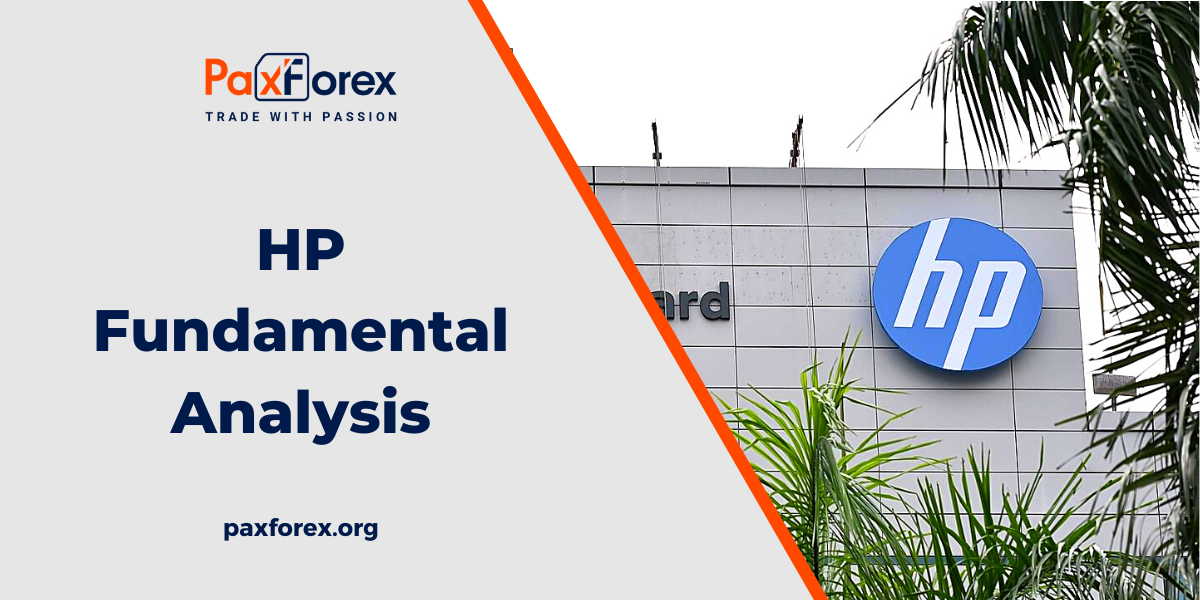
Source: PaxForex Premium Analytics Portal, Fundamental Insight
If you're reading this article, you probably already know that HP faced some serious challenges last quarter. Overall, in its fiscal Q3, which ended in July, the company reported a 25 percent YoY decline in the number of computers sold.
Sharp price increases could not fully offset the decline in sales. Q3 revenue of $14.7 billion was down 4.1% YoY, falling short of analysts' expectations of $15.6 billion. Earnings of $1.04 per share were in line with expectations and up slightly from a year ago. These 2021 numbers, however, are not a particularly tough comparison. Perhaps worst of all, CEO Enrique Lores foresees further weakness; the company has lowered its full-year earnings forecast.
The 8% slump in HP stock that followed immediately after the release of its fiscal Q3 results has since increased to nearly 11%, pushing the stock 30% below its June peak.
However, this big pullback is turning into a buying opportunity, despite the bearish outlook for the personal computer business. HP could get out of the PC business entirely right now, and the stock would still be worth more than its current price. Why? Because printers and printing supplies are a much bigger, better, and more sustainable business for this company than is commonly assumed in the market.
Yes, personal computers are HP's largest business by revenue. Last quarter alone, the company sold $10.1 billion worth of personal systems, which is 69% of its total sales. The other 31%, of course, is related to printing. These proportions are in line with the company's long-term norms.
The bulk of HP's revenues come from its currently struggling personal computer division.
Nevertheless, HP's business structure still underestimates the fact that profit margins on computers are notoriously low, while profit margins on printers and printing supplies are surprisingly wide. Although HP does not disclose these details in its reports or documents, a little analysis of revenue and operating profit margins by individual segment makes this clear.
However, HP's main profit center has always been printers and printing supplies.
HP generally makes more profit from its printing business than from its PC business. The spikes in PC purchases during various periods of the pandemic briefly changed this dynamic. For most of this year, however, the dynamic has returned to its normal.
But that's not the main point here.
In the first half of the current calendar year, HP's printing division posted operating profits of just under $2 billion. Given the company's history, there's no reason to believe that this division will stray far from its usual $3.6 billion annual figure, either this year or next. At the same time, thanks to the recent slowdown in PC sales, HP's computer business appears to be returning to its usual annual profit figure of about $3.0 billion.
Here's the thing: With a market capitalization of just under $30 billion, a price-to-earnings ratio of just 5.1, and a projected price-to-earnings ratio of just 6.5, the market has probably already appreciated the complete and lasting collapse of HP's personal computer business and then some. In other words, even after deducting non-operating expenses such as taxes and interest payments, HP's printing business alone can still support a stock price above the current price of about $28.
The printing business is certainly a more sustainable profit center. While people and businesses typically replace computers only every few years (four years on average), companies and consumers who print regularly need new toner and ink year-round.
This demand is also not diminishing.
Although the advent of the PC was once accompanied by much hype around the idea of a "paperless office," technology market researcher IDC estimates that 2.8 trillion documents will be printed worldwide in 2020, only 14% less than in 2019, even with the demands of staying home caused by the pandemic. While the number of documents printed each year worldwide has been slowly declining for some time, a slight decrease of one digit is the norm and will remain so through 2025, according to IDC.
Tie it all together. Whether or not there are PC issues, HP's printing business alone makes the stock worth watching at its current value. The key to recovering the stock price will be greater investor acceptance of this reality, which may take time.
As long as the price is below 30.00, follow the recommendations below:
- Time frame: D1
- Recommendation: short position
- Entry point: 27.21
- Take Profit 1: 25.00
- Take Profit 2: 22.00
Alternative scenario:
If the level of 30.00 is broken-out, follow the recommendations below:
- Time frame: D1
- Recommendation: long position
- Entry point: 30.00
- Take Profit 1: 32.00
- Take Profit 2: 34.00













